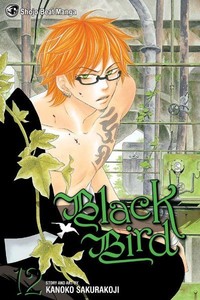Review
by Rebecca Silverman,Black Bird
GN 12
| Synopsis: |  |
||
With Sho's cult firmly rooted in the village, Kyo and his daitengu must spend most of their time undoing the damage that he has done. Since Hoki was injured in the last battle, both Kyo and Hoki's brother Sagami want him to stay at home, but this leaves Hoki feeling unwanted. What will he ultimately decide to do, and what does Zenki have to do with his plans? |
|||
| Review: | |||
Despite a reputation as a romance mangaka, Kanoko Sakurakoji really does a better job with dark fantasy. Or perhaps that somewhat blanketing statement should be amended to “Kanoko Sakurakoji's Black Bird has been a better series since the focus shifted away from romance.” As has been mentioned before, when Kyo is off running the village instead of romancing Misao, Sakurakoji's story takes a turn for the intense and becomes something rather more than it has been. This volume opens with the aftermath of Sho's attack in volume eleven. Hoki, younger brother of the chief daitengu Sagami, has been wounded, and despite his protests, both Kyo and Sagami tell him that he is better off staying behind. Hoki is less than pleased by this, despite the fact that he is clearly very much needed back at the ranch. When Sho inevitable tries to attack while Kyo is out, Hoki comes to Misao's rescue...or he should. Ayame gets a surprising burst of gumption before Hoki is able to step in. What effect this has on him later is debatable; much is left to readers' interpretation. The closed quality of Hoki's character is what makes him so useful as a character in this volume. We almost never get inside his head, either through his words or his thoughts. When he does choose to reveal tidbits of his past or inner monologue, there is always a very real sense that he is holding something back. These are not traits shared by our protagonists Misao and Kyo, and it makes him more interesting than yet another powerful tengu might otherwise be. Speaking of Misao, this is a volume of realizations for her. She has long thought that Ayame and Sagami had a slightly off relationship (as has Kyo), and conversations with the other girl force her to see them in a different light. It may be another moment where she understands that she is not living among humans, with the human values that she is accustomed to. The very idea of “humanity” is raised several times in this book, with Kyo ridiculed for, essentially, wanting monsters to live like people. What is it about humanity that makes people different from the tengu? This is an issue that both Misao and Kyo are beginning to grapple with the longer they stay in the village, and it is a philosophical (albeit slightly sophomoric) question that helps lead the series from somewhat prurient to a more thoughtful story. Likewise Misao's realization that sweetness, light, and trust do not always win the day lends the volume a validity that earlier books focused on sex did not have. Misao's potential epiphany also is interesting in terms of what we typically see in shoujo romances, with the heroine's sweetness overcoming all obstacles before her. It will take more than a spoonful of sugar to make Sho go down, something Misao is coming to understand. The other major plot thread in this book belongs to Zenki, whose tattooed flesh adorns the cover. His sections detail Sho's ruthlessness and underhanded tactics, as well as highlighting how utterly opposite Kyo is from his brother. Readers of Kazuya Minekura's Saiyuki will be unsurprised by some of the events in his plotline, but Sakurakoji does a decent job of making us care for the hitherto neglected character while showcasing the strength of her villain. And Sho is a good antagonist. By turns ruthless, vicious, and suave, his villainy coupled with his cult-leader charm makes him one of the stronger, more defined characters in the text. The lengths he'll go to to sabotage his brother are impressive and once again bring up the underlying theme of “humanity.” One thing Sakurakoji is very consistent with is her art. While one could say that she took a page out of Tite Kubo's book by dressing all the tengu in black kimonos, Misao changes clothing frequently, giving scenes a bit of variety. Backgrounds are basic and unremarkable, allowing for a sense of remoteness and cold but not going much beyond that. It is functional, serviceable art that looks a little better than average, as it has all throughout the series. While some readers may have given up on Black Bird awhile ago, this and the previous volume may be enough reason to go back to it. Readers in it for the smutty romance will be disappointed here, as there is barely even any innuendo, but if that plot device was grating on you, the war for the tengu village may restore your interest. If nothing else, Black Bird is a compulsive read, and it looks like if we give her long enough, Kanoko Sakurakoji may deliver a better story than some of us were anticipating. |
| Grade: | |||
|
Overall : B-
Story : B-
Art : B
+ Interesting character arc for Hoki, particularly if you enjoy psychoanalyzing your characters. Sho is a terrifically evil villain, Misao and Kyo's interactions are less creepy. |
|||
| Production Info: | ||
|
Full encyclopedia details about Release information about |
||